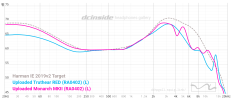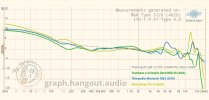I also have the Zero 2 and they are IEMs that tolerate E.Q. very well but without E.Q. I find them dull and with a serious lack of extension of the high frequencies (very difficult to fix because it is not enough to just raise it). I am not a fan of the Harman curve because I find it tiring and claustrophobic. In my opinion an Upgrade of Zero 2 could be Simgot (in my ears at the moment I have the EW300 that I use for gaming because I find them quite balanced and ultra comfortable), but if you had Supermix in mind, in my opinion it is not worth the effort. In my opinion the EW 300 are better with a slightly fuller sound without sacrificing too much of the highs. But from what I understood from your tastes (maybe I'm wrong) in my opinion you make a huge leap with Sennheiser IE200. I liked them so much that I got the IE600 (it's a more excited and refined IE200), because IE200 they handle the frequencies from 5000 to 15,000 Hz well (as the price goes up, it's exactly the area where you can hear the differences). Between Supermix and IE200, I'll go with the IE200 all the time. I wouldn't waste time waiting for the Blue2, because apart from a few slight changes, there are no real differences and they all look the same now. For IEMs under $100, I now have my favorite, which is the Rose Technics Star City 5 Pro (they overdid it with the imagination), which also lacks a bit of air, but handles everything else wonderfully and makes up for it (I have preferences but not in a Taliban way). Artti T10 is better in the treble extension but worse in everything else, including comfort. Unfortunately IEMs with good high frequency management and air under $100 I have never heard or seen (looking at the graphs). You don't need to spend astronomical figures to get a good result, but you won't get it by spending very low figures for obvious reasons (the time to tune an IEM well has a cost and it's not enough to apply some filters on the nozzle to get it and no intelligent person would sell a product with certain qualities at too low prices). As much as technology has advanced and even a VW Golf R is very fast (like a luxury sports car from 20 years ago), to have very high performance you can't look at popular prices and say, as many do even in this Topic, that already with $25 you already have the best you can have, it's because they are subjectivists who don't know they are yet. The data are there...


